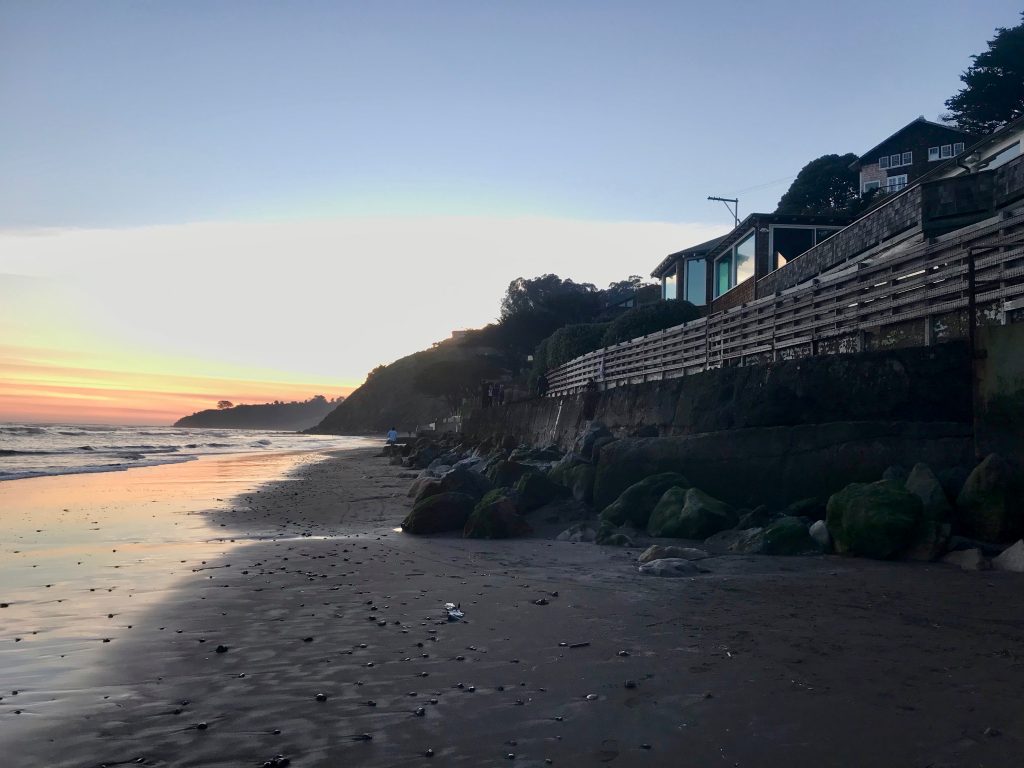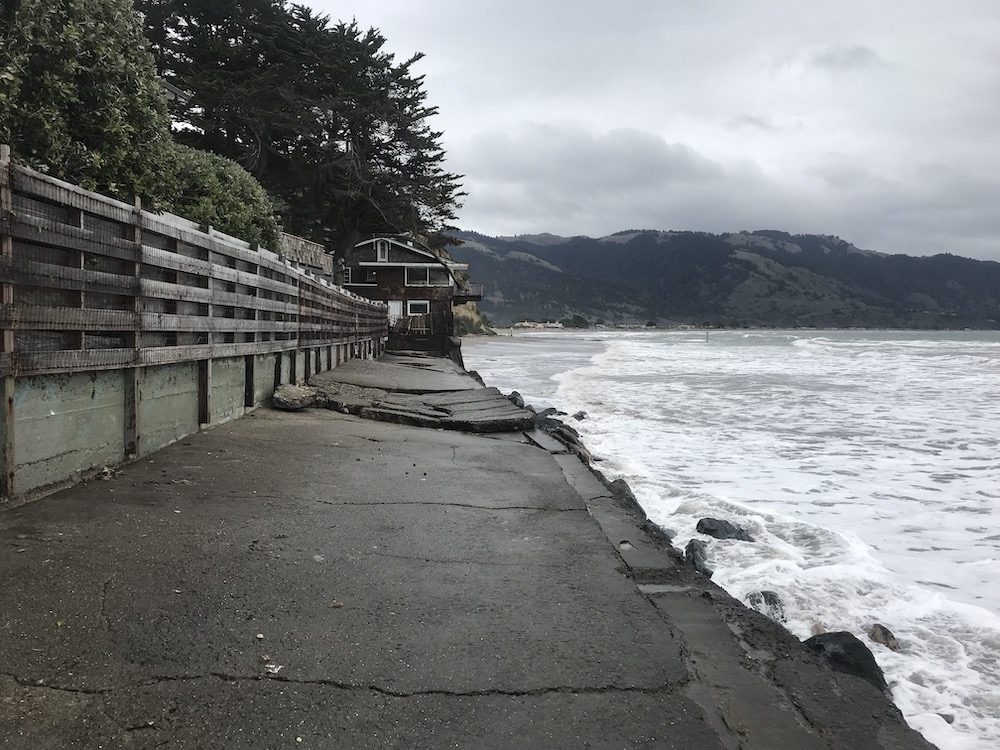
07.15.20
Money Can’t Buy Everything ... For Example, a Really Big Coastal Seawall in California in This One Situation I Will Tell You About
By Surfrider Humboldt
A billionaire’s seawall is not what most people think of when they think of Bolinas. The seaside town an hour or so north of San Francisco is best known as a reclusive hippie town with a reputation for keeping visitors out. It also garnered massive media coverage earlier this year by becoming the first, and so far only, California town to test all its residents for infection with SARS-CoV-2. The testing project, conceived by a San Francisco venture capitalist who’d moved to Bolinas a decade prior, raised more than $300,000 toward the effort including $100,000 from Mark Pincus, Zynga founder and Bolinas homeowner. By most accounts, the COVID-19 testing project exemplified the community cohesion that defines Bolinas.
That cohesion appeared in a different forum last week when the California Coastal Commission reviewed an application from Pincus (as his company “AMJT Capital”) to repair and remodel a seawall in front of his oceanside house on Brighton Ave. Built in 1910, the 4,813-square-foot house sits atop the sand, a situation that would not be permittable under the Coastal Act today. Because the house was built directly on the beach, thus dividing it, the seawall not only protects the Brighton Avenue property from high tides, waves, and storm surges, it often serves as the only path from the street to the pocket beach on the other side. People also stand on it to check the surf, fish off the side, observe wildlife or just hang out. This makes it more valuable to the community than the average seawall, a point many Bolinas residents emphasized in a series of well-produced videos during the hearing. Inland visitors to the coast, however, might prefer sand to concrete, as commission staff would point out.

The seawall
Seawalls are generally not allowed for homes built after January 1, 1977 because they increase erosion, hastening the destruction of our public beaches. However, since the house, purchased by Pincus in 2009 for more than $4 million, predates 1976’s California Coastal Act, it’s considered an “existing structure,” meaning Pincus has the legal right to fortify the associated seawall.
At issue in the Coastal Commission meeting, therefore, was not whether or not the seawall could continue existing, but how the Commission should approve it while protecting the public’s right to access the beach. Based on conversations with coastal engineers and the Bolinas Fire Department, and factoring in accessibility needs, Commission staff recommended the seawall be no wider than seven feet in order to provide more sandy beach for the public. Pincus wanted 16. The difference between the two would amount to about 2,500 square feet – or about 150 beach towels.

Prominent players
Pincus’s team included well known coastal developer attorney Steven Kaufmann and lobbyist Susan McCabe. Kaufmann has defended a number of controversial development projects including Santa Monica’s Shore Hotel, a massive illegal seawall in Laguna Beach and the proposed Banning Ranch development in Newport Beach, all of which were found inconsistent with the Coastal Act. The L.A. Times once referred to McCabe as “the most influential person on the Coastal Commission,” writing, “Lobbyist, winer-and-diner, political insider and owner of McCabe & Co., a Marina del Rey consultancy, McCabe by all accounts dominates the field of coastal developers’ agents. Many also consider her unrivaled in behind-the-scenes discussions with coastal commissioners.” In this case, four Commissioners – Chair Steve Padilla, Roberto Uranga, Mark Gold, and Erik Howell noted that McCabe had met privately with each of them before the meeting to review a briefing book prepared on behalf of Pincus advocating against staff’s recommendations, with Gold noting he spoke with McCabe for an hour about the project.
‘What feels like a very aggressive campaign’
Standing in front of the seawall on a sunny day, long-term resident Jack Seidman reminisced about taking his daughters to the beach over the years. “We’ve crossed over this seawall thousands and thousands of times,” he said. The same video featured Pincus himself, sitting along the wall in front of his house with his two young daughters extolling the importance of the wall as a place to sit, evaluate the surf and watch the sunset. He affirmed his intention “to rebuild this seawall for these guys, for the next generation of kids that are going to grow up in Bolinas.” (The question of extending the life of the beach for future generations via managed retreat did not arise.) Public comment continued for another 45 minutes, most of which consisted of similar montage videos of residents advocating on behalf of the seawall, sometimes in front of Pincus’s house, sometimes featuring similarly charismatic children, sometimes with the ocean and surfers in the background, waves crashing as dogs scampered by.
To regular Coastal Commission attendees, the series of videos illustrated a particularly slick – and expensive – display aimed at swaying the Commission to the applicant’s way of thinking. Commissioner Sara Aminzadeh noted, “It’s a bit remarkable. This is one of the most robust pro-seawall campaigns I’ve ever seen… Much has been made of the seawall for public access but this is essentially a private residence of an individual.”
‘Every bit of it is precious’
Commissioner Linda Escalante also commented on the presentation, saying it appeared “made by the best talent… because it was so rich in production value… I would obviously expect no less from the developers of Zynga.” She continued, “However, I’ll be honest, I’m usually more trusting of more authentic presentations” and asked North Central Coast District Director Dan Carl to revisit the environmental justice analysis as to “why this particular sizing of this project is the way it is.”
“It goes to the question of who’s fortunate enough to live on or near the shoreline versus the folks who need to travel from far away to come and enjoy the beach,” Carl responded. That question informed staff’s recommendation to reduce the amount of armoring in favor of providing more sand for visitors from inland communities to enjoy the area, he explained. “These beaches are obviously well used and not just by the local residents,” Carl continued. “[Sand] is obviously a finite resource and every little bit of it is precious.”
‘But for the armoring… there would be a beach’
Commissioner Donne Brownsey spoke in support of staff’s recommendations, pointing out that “but for the armoring on this property, there would be a beach where the public would have full access” and that although the seawall provides some public access, it has become utilized by the public “because, in fact, they do not have beach to walk across because of the structure.”
After two hours and 40 minutes of presentation, public comment and commissioner questions to staff, Brownsey motioned to approve the seawall permit as staff had recommended. Commissioner Aminzadeh seconded, again calling attention to the potential disparity between those who can afford expensive attorneys and consultants, and those applicants who cannot. “It’s hard for me to imagine an organic grassroots campaign from the community of Bolinas to debate whether the seawall should be six feet or seven or eight feet,” she said. “I am being thoughtful, as I know we all are, about who is accessing this process and the fairness of it and I do think that having resources for attorneys and video production makes a difference. That’s just the case.”
Designing from the dais
Commissioner Katie Rice, a Marin County supervisor, who had advocated the wall be rebuilt “as wide as possible,” offered a competing motion to increase the seawall width from staff’s recommendation of seven feet to 10 feet. Commissioner Escalante countered with “this house and the one downcoast… are responsible for the loss of beach to begin with… and this wall will obviously continue to perpetuate that.” After lengthy discussion among commissioners and staff, an amending motion was put forth to approve a seawall eight feet wide that included seating.
The Commission splits, 7-5, for an 8-foot wall
Ultimately seven commissioners – Brownsey, Howell, Escalante, Rice, Wilson, Uranga and Padilla – supported an eight-foot seawall – with five Aminzadeh, Hart, Dayna Bochco, Carole Groom and Effie Turnbull-Sanders – voting against the expanded width. Pincus will not get his 16-foot seawall, but the residents of Bolinas, and the visitors to that pretty beach, will get so much more.

